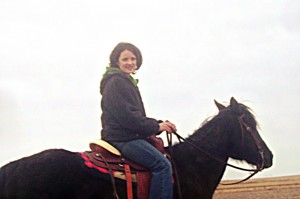 I got a phone call last weekend out of the blue. The guy had been searching online for horse trainers in the area and found an ad I had placed probably eight years ago (before I had kids) when I was looking to take in outside horses to train. He wondered if I could help him with two horses he was wanting trained, and me being the horse enthusiast I am, I said “Sure.” I had to follow that up with a lengthy explanation of how I am a mom of three, work full time, and almost never have the time to ride anymore–but I assured him that I could help him put some rides on these horses of his.
I got a phone call last weekend out of the blue. The guy had been searching online for horse trainers in the area and found an ad I had placed probably eight years ago (before I had kids) when I was looking to take in outside horses to train. He wondered if I could help him with two horses he was wanting trained, and me being the horse enthusiast I am, I said “Sure.” I had to follow that up with a lengthy explanation of how I am a mom of three, work full time, and almost never have the time to ride anymore–but I assured him that I could help him put some rides on these horses of his.
I thought about it from every angle. I could take in his horses for a month, and keep them at our place…but I didn’t want to throw them in with my own horses and risk them fighting and running and getting injured, as horses will often do when you merge two herds together. I could try to find space for a makeshift pen for the two outside horses, but our cow herd is taking up two corrals since it is calving season, and other than a very small pen I couldn’t think of a place I could keep two extra horses. I could just leave them at his place and work with them as best I could without the aid of a round pen or corral. And any way I looked at it, it didn’t seem like I could reasonably expect to ride them both daily, so there wasn’t any sense in bringing them to our place.
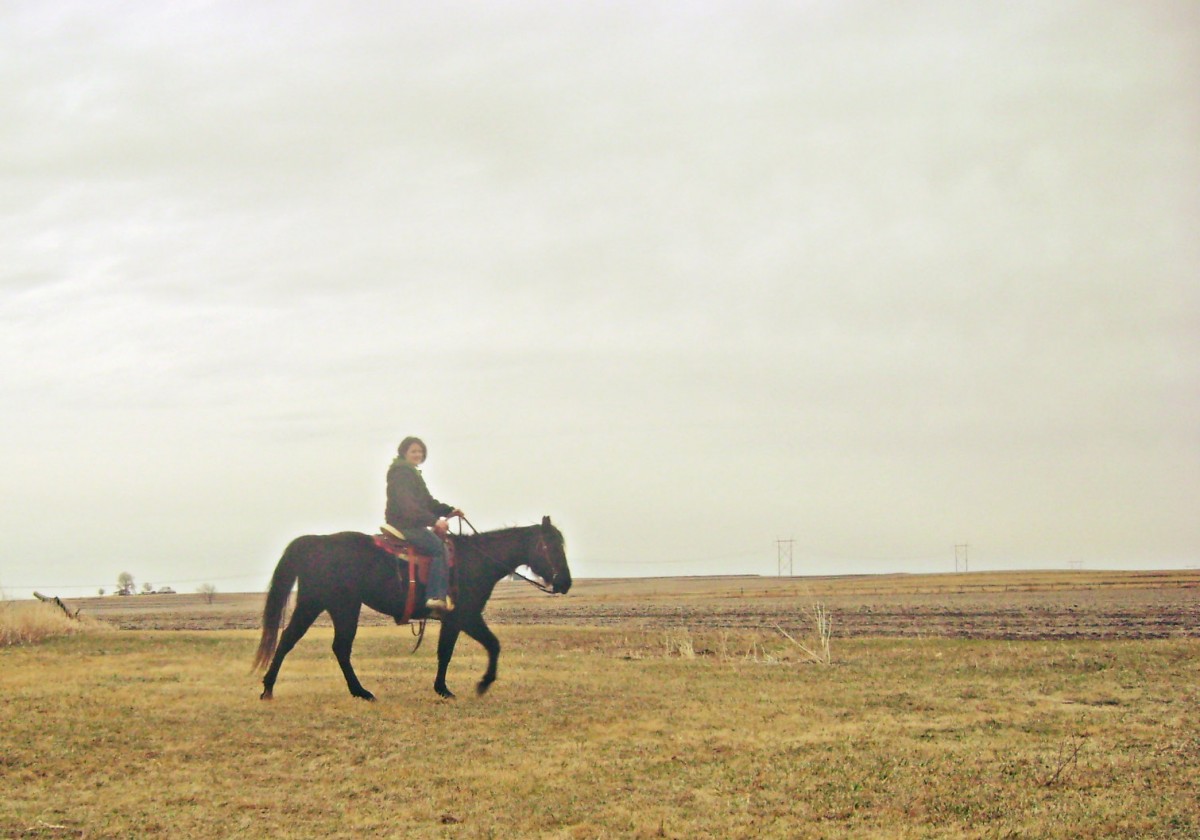 So I called him back and said I would come take a look, we could talk things over, and if it was okay with him I would just come over to his place and ride whenever I could, for a few times if it was necessary, or up to a month if that’s what he wanted. So tonight after supper I asked my husband if we had time to go work with these horses, and he said sure we could drive out there after our evening chores.
So I called him back and said I would come take a look, we could talk things over, and if it was okay with him I would just come over to his place and ride whenever I could, for a few times if it was necessary, or up to a month if that’s what he wanted. So tonight after supper I asked my husband if we had time to go work with these horses, and he said sure we could drive out there after our evening chores.
Upon arrival, I met Sugar and Maverick, and their owner, Nate. Maverick is a five year old Foxtrotter gelding, black with a white snip on his nose and white socks. Nate said he was told the gelding was green broke, and that he had been riding him a little, but couldn’t make him go in any particular direction. Sugar is an aged Quarter Horse mare that is supposed to be kid-broke, but Nate was unable to get a bit in her mouth so he had not ridden her yet.
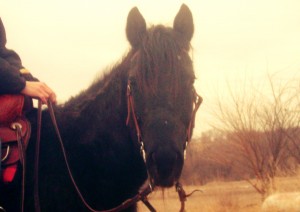 I decided to work with Sugar, since she seemed like it could be an easy fix. I had brought along three different bridles: a bosal, a shanked snaffle, and a ring snaffle. I fitted Sugar with my bosal, which she accepted willingly, and then saddled her up. She seemed like a horse who would rather avoid being handled, but wasn’t afraid (I made a mental note that yes, a kid-horse will likely get “sour” and not want to be caught or worked). She didn’t show any resistance, other than the urge to go over and graze near Maverick, which was understandable. But I got to wondering about the bosal and whether or not I wanted to ride her in it, since it is very mild (a rope halter has more rate than my bosal). So after saddling, I decided to put my bridle with the shanked snaffle on her. She was not difficult to bridle, just didn’t willingly open her teeth for the bit, but I was patient and we got through it without any fuss.
I decided to work with Sugar, since she seemed like it could be an easy fix. I had brought along three different bridles: a bosal, a shanked snaffle, and a ring snaffle. I fitted Sugar with my bosal, which she accepted willingly, and then saddled her up. She seemed like a horse who would rather avoid being handled, but wasn’t afraid (I made a mental note that yes, a kid-horse will likely get “sour” and not want to be caught or worked). She didn’t show any resistance, other than the urge to go over and graze near Maverick, which was understandable. But I got to wondering about the bosal and whether or not I wanted to ride her in it, since it is very mild (a rope halter has more rate than my bosal). So after saddling, I decided to put my bridle with the shanked snaffle on her. She was not difficult to bridle, just didn’t willingly open her teeth for the bit, but I was patient and we got through it without any fuss.
So then I just walked her in a few circles, testing her response to rein pressure and how she would stop, back, etc. Watching her and how she responded, I guessed she had been ridden before. So I stopped her, gathered the reins, and started to put my foot in the stirrup. The minute my foot left the ground, her head came around, teeth bared, ears pinned and whites of her eyes flashing: totally a hateful horse! I put out my left elbow and bumped her sharply as her head came around towards me to bite. And continued to turn her towards me in a circle, watching her.
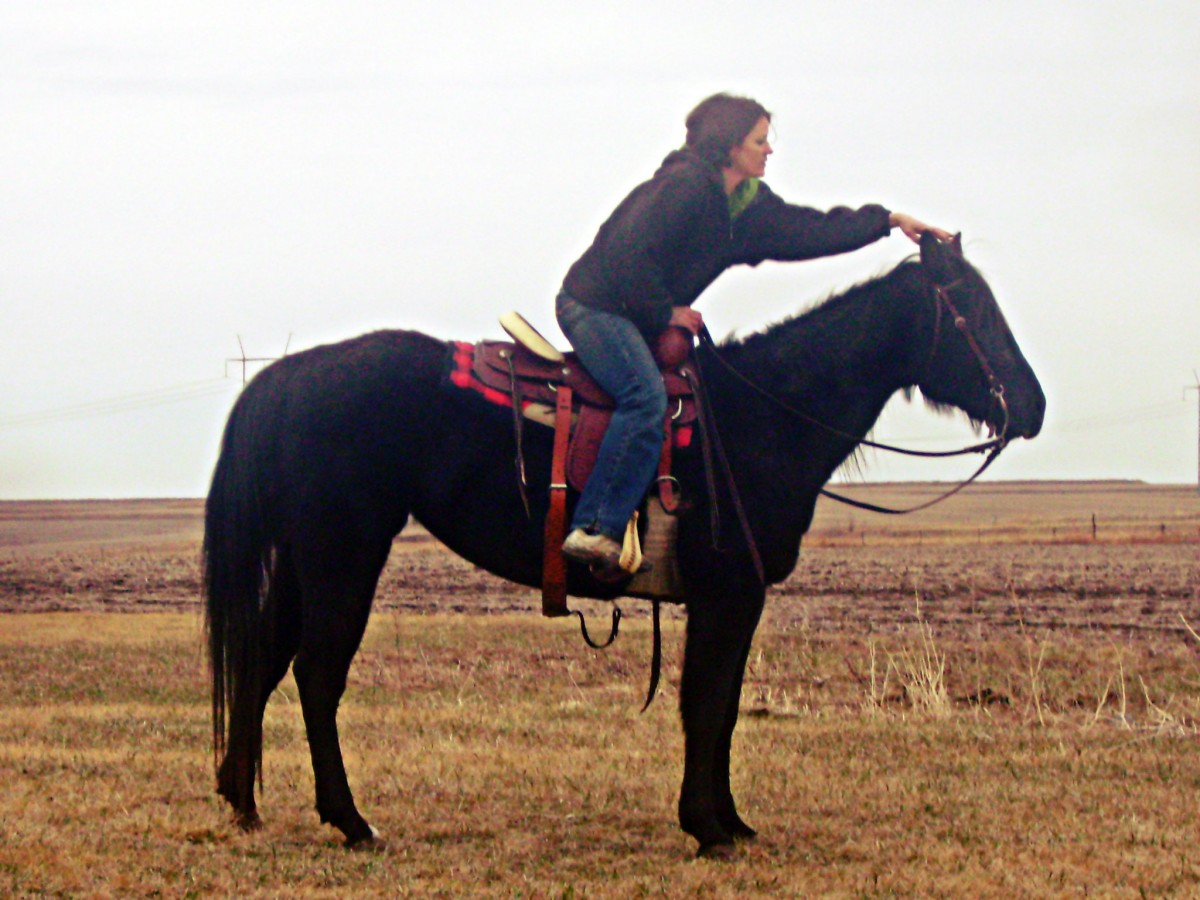 I remarked to the owner, “Did you see that?” I explained that she was warning me off, and that when she nipped at me I bumped her with my elbow. I told Nate that any time she reaches for you to bite, simply meet her head coming around, and instantaneously move your hand or elbow towards her mouth as it is coming around and bump her right on the side of her lower jaw. I told him that the handler’s correct response is not a retaliation, it is quicker than that, so that the horse actually thinks, “I did that to myself.” It’s like when you stub your toe on the step…next time you take that step you will lift your toe a little higher to avoid stubbing it. The mare will learn, if she meets an elbow every time she whips her head around to bite, that it is not fun to bite. I warned the owner that if she is not corrected for this (and watched carefully), she could really take a chunk out of someone and send them to the hospital for stitches.
I remarked to the owner, “Did you see that?” I explained that she was warning me off, and that when she nipped at me I bumped her with my elbow. I told Nate that any time she reaches for you to bite, simply meet her head coming around, and instantaneously move your hand or elbow towards her mouth as it is coming around and bump her right on the side of her lower jaw. I told him that the handler’s correct response is not a retaliation, it is quicker than that, so that the horse actually thinks, “I did that to myself.” It’s like when you stub your toe on the step…next time you take that step you will lift your toe a little higher to avoid stubbing it. The mare will learn, if she meets an elbow every time she whips her head around to bite, that it is not fun to bite. I warned the owner that if she is not corrected for this (and watched carefully), she could really take a chunk out of someone and send them to the hospital for stitches.
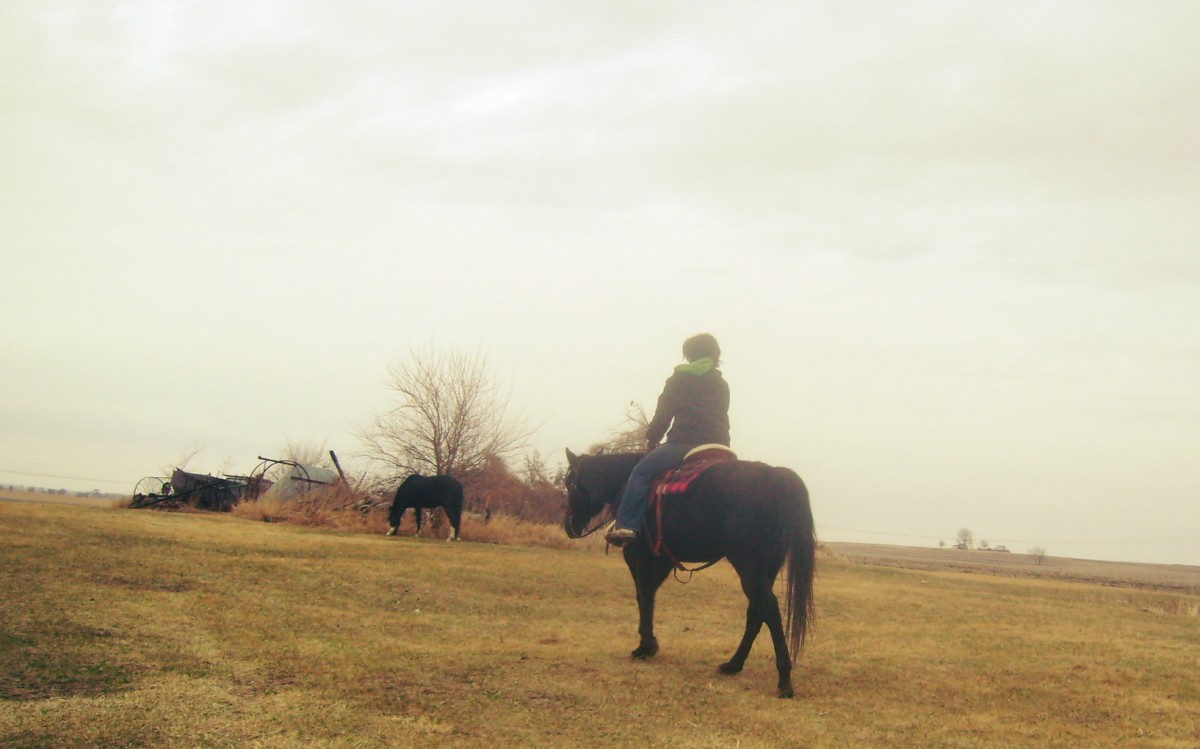 This nipping habit further confirmed to me that she had been ridden in the past, and most likely had been ridden quite a lot, and was “soured” to people getting on her. That was her only flaw, however. I tried twice more to lift my foot to the stirrup, and she would reach around with her teeth bared and ears pinned, but would stop when she saw my elbow….smart horse! So then, the third time I just climbed right on into the saddle. I explained to Nate that Sugar might have been spoiled by a lot of kid riders who would get scared when she bit them and would then leave her alone. Or she could have been in extreme discomfort if the person trying to mount really pulled the saddle sideways or wrenched Sugar’s back. So I gave her the benefit of the doubt on her reasons, but biting is never an acceptable behavior.
This nipping habit further confirmed to me that she had been ridden in the past, and most likely had been ridden quite a lot, and was “soured” to people getting on her. That was her only flaw, however. I tried twice more to lift my foot to the stirrup, and she would reach around with her teeth bared and ears pinned, but would stop when she saw my elbow….smart horse! So then, the third time I just climbed right on into the saddle. I explained to Nate that Sugar might have been spoiled by a lot of kid riders who would get scared when she bit them and would then leave her alone. Or she could have been in extreme discomfort if the person trying to mount really pulled the saddle sideways or wrenched Sugar’s back. So I gave her the benefit of the doubt on her reasons, but biting is never an acceptable behavior.
Once on her back, Sugar was an angel. We walked circles around their little farmstead, and it was fun to see her stride out in a smooth walk (she has an old injury on her right hind foot, plus her front left foot is crooked—so I didn’t know how sound she might be when riding, but she seemed perfect, and traveled along happily). She did not whinny or fret for the other horse, and when I sat back slightly she stopped on a dime. I told Nate that she obviously had been ridden a lot, and was very light-mouthed and responsive to the bit. I hardly had to touch the reins at all, and I told him that is very valuable in an old “kid-broke” horse, because they can get so spoiled and hard-mouthed and insensitive that they are not any fun to ride. So it was neat to find out that she really is a sweetheart once you get past the mounting stage.
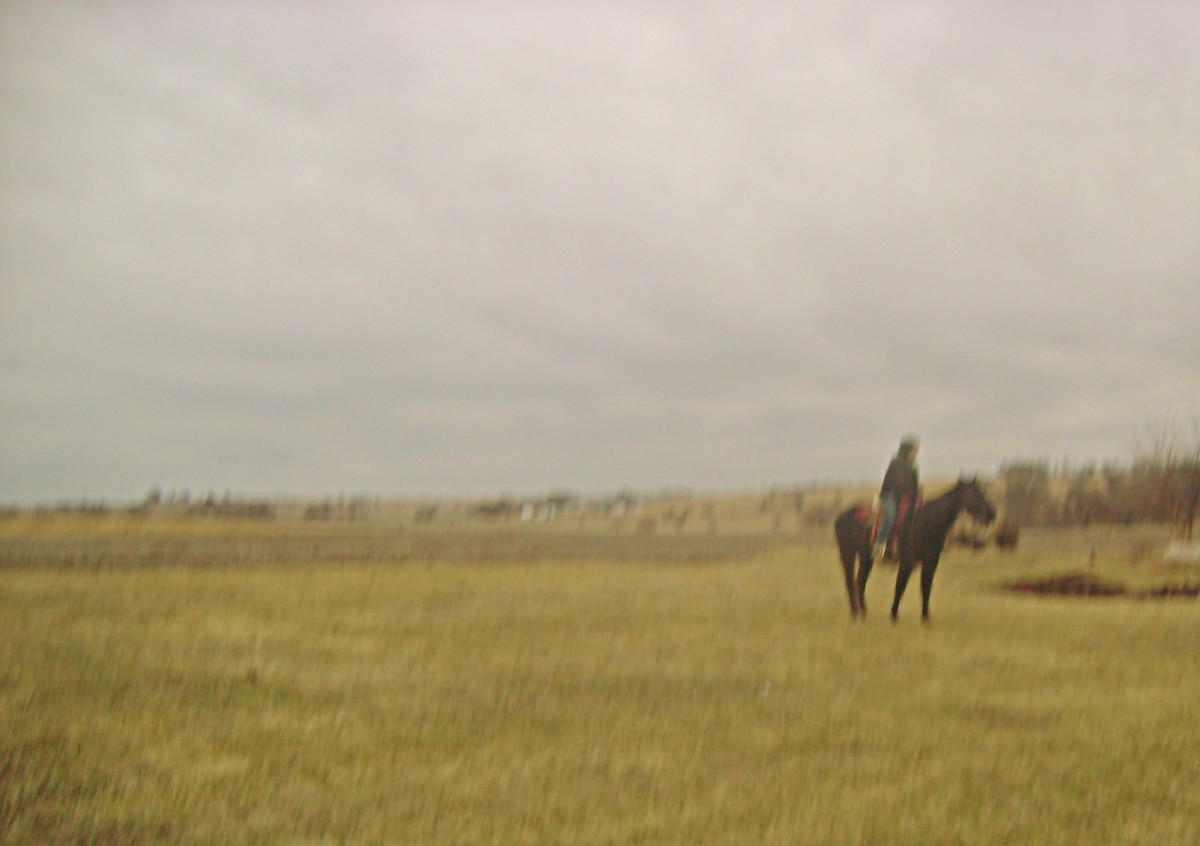 I practiced getting off and back on several more times, each time watching to see if she was going to bite at me, and only needing to visually block her (she stopped when she saw my elbow at the ready) instead of physically block her from biting. I explained that another remedy for her issue would be to train her to a mounting block. This would eliminate any sideways pull on the saddle, which is most likely what irritates her most about a person climbing on. And with a little bit of work, she will probably learn to stand still and accept a person getting into the saddle without any fuss.
I practiced getting off and back on several more times, each time watching to see if she was going to bite at me, and only needing to visually block her (she stopped when she saw my elbow at the ready) instead of physically block her from biting. I explained that another remedy for her issue would be to train her to a mounting block. This would eliminate any sideways pull on the saddle, which is most likely what irritates her most about a person climbing on. And with a little bit of work, she will probably learn to stand still and accept a person getting into the saddle without any fuss.
By this time, it was getting late and my children were growing restless from watching (two of them wanted to ride, and one wanted to go home), so we called it a good start. I promised to come back as soon as possible to work with Maverick. I hope to be able to take Sugar on some trails soon, and hopefully I can help her owners learn to ride her safely. I am excited about the prospects of riding new horses. I love starting something new! Let’s just hope that springtime arrives in full force very soon, and we have some really warm days to enjoy riding.
